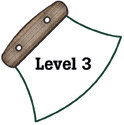
Alaska Science
Key Element A13
A student who meets the content standard should understand the theory of natural selection as an explanation for evidence of changes in life forms over time (Evolution and Natural Selection).
 |
Alaska Science A student who meets the content standard should understand the theory of natural selection as an explanation for evidence of changes in life forms over time (Evolution and Natural Selection). |
|
Performance Standard Level 3, Ages 11–14
|
|
|
|
Sample Assessment Ideas
|
|
|
Expanded Sample Assessment Idea
|
|
Procedure Students will:
Reflection and Revision
|
Levels of Performance |
||
|
Stage 4 |
Student work shows extensive evidence of knowledge regarding fossil tracks and animal behavior. Explanations are complete, correct, and give several different, yet defensible, explanations regarding what took place in the footprint puzzle. | ||
|
Stage 3
|
Student work shows evidence of knowledge regarding fossil tracks and animal behavior. Explanations are complete, but minor errors may be present, or a limited explanation is given for what took place in the footprint puzzle. | ||
|
Stage 2
|
Student work shows limited evidence of knowledge regarding fossil tracks. Explanations are incomplete and may contain significant errors. | ||
|
Stage 1
|
Student work shows little or no evidence of knowledge and regarding fossil tracks and major misconceptions are evident. | ||
Standards Cross-References
|
||
|
National Science Education Standards Biological evolution accounts for the diversity of species developed through gradual processes over many generations. Species acquire many of their unique characteristics through biological adaptation, which involves the selection of naturally occurring variations in populations. Biological adaptations include changes in structures, behaviors, or physiology that enhance survival and reproductive success in a particular environment. (Page 158) Extinction of a species occurs when the environment changes and the adaptive characteristics of a species are insufficient to allow its survival. Fossils indicate that many organisms that lived long ago are extinct. Extinction of species is common; most of the species that have lived on the Earth no longer exist. (Page 158) |
Benchmarks Small differences between parents and offspring can accumulate (through selective breeding) in successive generations so that descendants are very different from their ancestors. (Page 124) Individual organisms with certain traits are more likely than others to survive and have offspring. Changes in environmental conditions can affect the survival of individual organisms and entire species. (Page 124) Many thousands of layers of sedimentary rock provide evidence for the long history of the Earth and for the long history of changing life forms whose remains are found in the rocks. More recently deposited rock layers are more likely to contain fossils resembling existing species. (Page 124) |
|
Table of Contents | Return to Alaska Native Knowledge Network